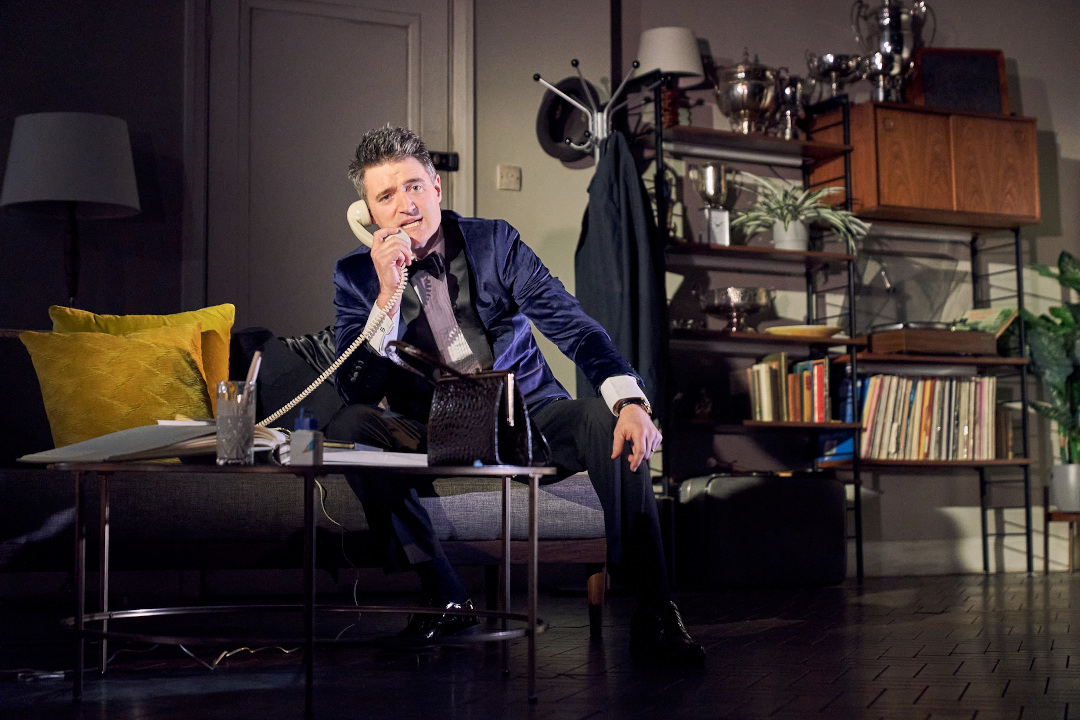
Dial M For Murder is perhaps best known as the 1954 film that starred Ray Milland and Grace Kelly, but it started life as a stage play. Written by Frederick Knott back in the late 1940s, it has been revived in one form or another many times since, but has it still got the power to thrill? The set-up has real potential: Tony Wendice is a one-time tennis player, apparently sharing married bliss with wealthy Margot, but she has been having a clandestine affair with Max Halliday, a writer of detective stories. That liaison is not as secret as she thinks, for Tony is well aware of it, and motivated by vengeful passion and by greed, he plans to bump her off and thereby get his hands on her riches. It should be gripping stuff.
Director Anthony Banks has shifted the action to 1963 and David Woodhead’s set design has the Wendices living in a light and airy garden flat in Maida Vale. ‘Light and airy’ could serve to describe the pervading mood, for this production of Dial M For Murder does not have darkness at its heart. In an attractive and nimble performance, Tom Chambers portrays Tony as a fast-talking charmer whose increasingly desperate, last-minute escapes from detection are masterpieces of quick-thinking under pressure. We can believe that this Tony might for a moment contemplate murdering his wife, but here he lacks the reptilian coldness that would make him a truly convincing killer. That absence of real menace pervades the whole show, and moments that should chill give rise to smiles and even laughter.
If the mood is perhaps rather too light, there is also a problem of pace. When they created that film version of Dial M For Murder, Alfred Hitchcock and Frederick Knott had the advantage of being able to show rather than tell. But in much of the first half of the original stage version most of the action is reported, rather than seen. The encounter between Tony and his old school acquaintance Captain Lesgate (Christopher Harper) is bogged down with stodgy expository dialogue, and fails to convince. Lines such as, ‘Why are you telling me all this?’ become a hostage to fortune. The programme notes reveal that Knott felt more comfortable as a screenwriter than he did as a playwright, and there are times when it shows.
However, matters improve greatly in the second half. There is more on-stage action, and the clever twists and turns of the narrative arrive at pace and command attention. Christopher Harper appears again, but this time as the very astute Inspector Hubbard, and he breathes real life into the role. Initially appearing to be just an ordinary no-nonsense copper, Hubbard gradually reveals that he is more than a match for the devious Tony. However, elsewhere there are weaknesses in characterisation. Sally Bretton is an attractive Margot Wendice, but the part is written so thinly that there is little she can do to invest her with any real individuality. No contemporary playwright would escape censure if their central female character was so under-written.
Anthony Banks and his team have gone some way to update this play, and there is wit and energy in many of the performances, including Michael Salami’s lively and genial Max Halliday, Margot’s not-so-secret lover. Lizzie Powell’s lighting, too, is often very effective at injecting some zing into proceedings, but overall, this show lacks real bite. That’s partly because Banks has gone for a lighter tone than might have been desirable, but it’s also because Dial M For Murder is showing its age. In its various iterations over the years it has proved enduringly popular, but now a more radical re-write is needed if we are not to put this old warhorse out to grass. ★★★☆☆ Mike Whitton 12th February 2020
Photo by Manuel Harlan


